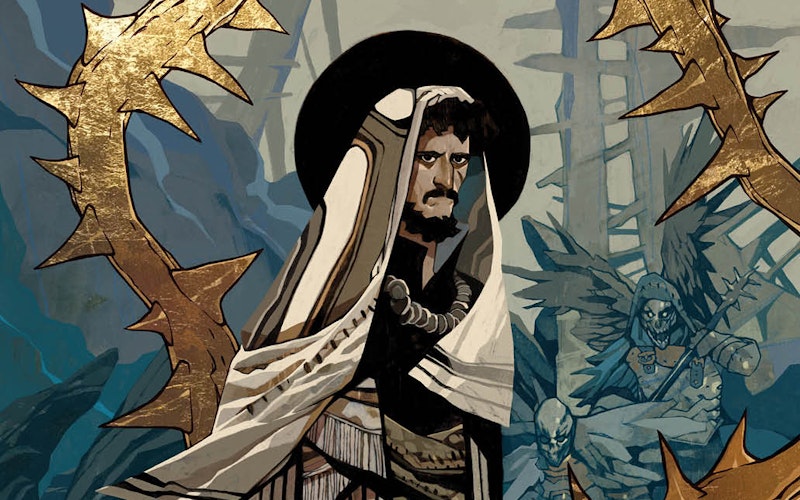
Culture At Large
Judas, The Goddamned, and the Bleakness of the Bible
Story is a powerful part of faith. Neuroscience suggests that narratives help us experience empathy and retain information, and the Bible is perhaps the ultimate example of this at work. Bible stories give us early lessons in right and wrong, love and sacrifice. We remember visionary leaders like Moses and Noah, as well as villains like Exodus’ Pharaoh or the New Testament’s Judas.
But, like all good stories, the Bible also contains areas that are open to interpretation. There are cracks that allow our imaginations to slip in and think about the people whose stories we’re reading.The perspectives offered in artistic renderings of Bible stories—particularly those from non-believers—provide a fascinating opportunity for dialogue in this regard. Stories created by artists who are compelled creatively by the Bible, but also bring a skepticism and questioning nature, let us look at familiar texts with new eyes.
Two recent comic book series present intriguing, non-orthodox interpretations of biblical stories: Jeff Loveness and Jakub Rebelka’s Judas; and Jason Aaron, R.M. Guera, and Giulia Brusco’s The Goddamned. Both comics draw on centuries of influence from religious and comic art, as well as the authors’ own worldviews, to lend complexity to stories we think we fully know.
With Judas, writer Jeff Loveness explores the afterlife of Judas Iscariot. He aims not only to bring empathy to the character of Judas, but also to explore ideas of destiny, redemption, and doubt. The first issue focuses on the frustration and uncertainty that led Judas to betray Christ, ideas influenced by Loveness’ own experiences growing up in the church and leaving as an adult. Among other things, Judas suggests that even being right next to Jesus as he’s performing miracles doesn’t exclude someone from the doubts that accompany faith, an idea that causes us to examine the disciples in a much more humanizing light.
Loveness is clearly moved by the themes of the New Testament. So is artist Jakub Rebelka, whose art pairs with Loveness’ writing to create a poetic, meditative comic. Rebelka’s illustrations feel progressive in their depiction of the characters (they definitely don’t sport European features), while also displaying a classical approach. Rebelka uses a flat, simplified perspective that resembles stained-glass windows or religious iconography. Judas walks through hell sporting a black halo, resembling an anti-saint. In both the text and the art, Judas takes traditional forms, then upends them to get readers to dive deeper into the story.
Judas asks questions about pain and suffering. The Goddamned, which is set in the days leading up to the Old Testament’s Great Flood, offers an answer of sorts. Why is there suffering? According to writer Jason Aaron, the answer is man. Aaron’s primary interest is in exploring the depravity of mankind at its lowest, when God decided to wipe the slate and start over. Aaron and his collaborators approach this exercise—just how bad would things have to get for people to be completely beyond redemption?—through writing and art that appreciate both the epic storytelling of the Old Testament and the artistic possibility of the comics medium.
The images of operatic desolation seem to glow on the page.
The hideous land depicted in The Goddamned is peopled by brutal tribes of inbred savages whose main activities are stealing, killing, and raping. It’s a pre-apocalyptic hellscape complete with feral kids, warlords, and roving anti-heroes. Our main character is Cain (yes, that Cain), who’s spent the centuries since he murdered his brother unable to die, condemned to witness mankind’s spiral into depravity.
While Cain seeks to end his curse, we’re also introduced to Noah and his family, gathering resources to build the ark. But this Noah isn’t the benevolent patriarch we know from Sunday school. He’s an enigmatic, merciless, cult-like figure who uses slave labor.
As incredibly (sometimes comically) horrible as the world of The Goddamned is, the fallen mankind it presents is scarily relatable. These characters defile their environment and take from each other with no thought to the consequences. They have no purpose but destruction, consumption, and exploitation. We may not be the cave people depicted here, but we can recognize their instincts. It begs the question: how far off are we from engineering our own divine destruction? The Goddamned seems to suggest that we’re closer than we’d like to think.
As such, the series is bleak, but also fantastical, making room for epic beatdowns and supernatural beings in a tale that recognizes the scope of its source story. In addition to Cain’s warped hero’s journey, illustrator R.M. Guera and colorist Giulia Brusco use the color-saturated approach taken by films like Mad Max: Fury Road. They create images of operatic desolation that sometimes seem to glow on the page.
Neither of these series is without theological problems, yet both Judas and The Goddamned display the powerful dramatic pull of the Bible, even to those who don’t believe in it as truth. Works like these remind us to make room for other perspectives in how we consider Scripture. We don’t have to agree with the way those stories are interpreted, but we should welcome the opportunity they present. It’s a chance to re-encounter the power of the biblical narrative, and engage with beautiful and difficult questions about our faith.
Topics: Culture At Large